Greater accuracy in gauging blood coagulation

Thrombin plays a key role in various pathologies of the haemostatic system. Overexpression of thrombin can result in thrombosis, whereas its underexpression might lead to haemophilia. Therefore, accurate monitoring of thrombin activity is crucial for determining the proper treatment of a given patient, as this correlates with the ability of blood to coagulate. A tool for monitoring the activity of thrombin over time is the so-called thrombin generation test (TGT).
In a collaborative project headed by Floris Rutjes (Radboud University Nijmegen, Netherlands), novel thrombin-specific fluorogenic peptides were developed for accurately determining thrombin concentrations by the TGT.
Adding such a peptide substrate to a clotting plasma sample results in its hydrolysis by thrombin, thereby releasing the fluorophore.
Spectrophotometric measurement of fluorophore release increases the sensitivity and thus accuracy of the TGT, yielding various essential coagulation parameters.
The use of fluorogenic peptides in combination with the TGT is expected to find broad application in the field of haemostasis and thrombosis.
More information: Floris P. J. T. Rutjes, Fluorogenic Peptide-Based Substrates for Monitoring Thrombin Activity, ChemMedChem, dx.doi.org/10.1002/cmdc.201100560
Journal information: ChemMedChem
Provided by Wiley














